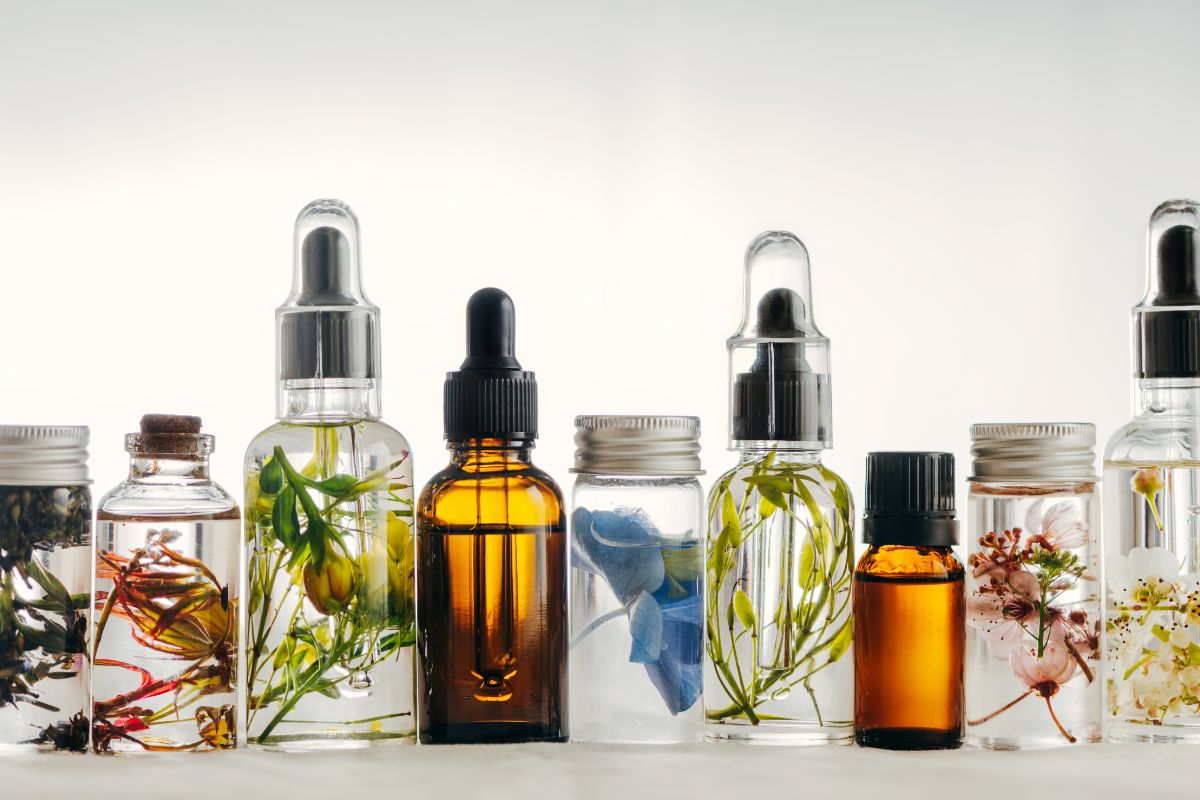Have you ever stopped to think about the power that natural plants have to care for our health? Seriously, it’s impressive. Long before the pharmaceutical industry existed, our ancestors already knew how to use herbs to heal the body and calm the mind. This knowledge, passed down from generation to generation, is a true legacy that deserves to be rescued and valued today. And you don’t have to be an alchemist to start — with simple ingredients and a bit of patience, you can already work wonders at home.
One of the easiest and most effective ways to enjoy the benefits of plants is through medicinal oils. They’re versatile, easy to use, and full of amazing properties. Great for relaxing massages, pain relief, skin hydration, hair care… and they even have that delicious smell that brings instant peace. And the best part? You have full control over what goes into your oil — no preservatives or strange ingredients.
Today I’m going to show you how to make a homemade medicinal oil with natural plants — step by step, just like I learned from my grandma and perfected over time. Let’s talk like we’re chatting in the backyard, sipping tea while preparing this incredible oil. Ready? Then let’s go!
🌿 Why Use a Homemade Medicinal Oil?
First of all, let me tell you something: I grew up watching my grandma prepare these oils with so much care. She mixed chamomile, lavender, rosemary… each scent had a memory, and each recipe had a purpose. It was magical. And it worked, believe me!
These oils weren’t just nice-smelling and pleasant to apply on the skin. They really helped! When someone at home had a headache, my grandma would grab a bit of peppermint oil and massage the temples. If it was back pain, out came the rosemary oil. And it wasn’t just physical care — the scent of lavender oil, for example, would calm the entire house. It was care that went beyond the body — it was emotional too.
Today, we know many of these uses have scientific backing. The active compounds in plants help relieve pain, reduce inflammation, nourish the skin, and even lift the mood. And the coolest part: no harsh chemicals, no weird additives — just pure nature. It’s a real, accessible, and safe alternative for anyone seeking a more natural lifestyle.
Plus, making your own homemade medicinal oil is a way to reconnect with the rhythms of nature and with real self-care. It’s about slowing down, choosing the right plant, preparing everything mindfully… all of that is already part of the healing process. It’s not just about the final product — it’s about the journey. And that, my friend, is priceless.
✋ So, What Is Medicinal Oil Used For?
Medicinal oil is much more than a simple cosmetic. It works as a natural ally in promoting physical and emotional well-being. The compounds extracted from plants have therapeutic properties that help relieve muscle and joint pain, calm the mind during stress and anxiety, and contribute to healthier skin. Plus, many oils have anti-inflammatory, antiseptic, and relaxing effects — all without resorting to industrial products full of hard-to-pronounce ingredients.
Its versatility is also a huge plus. The same oil can be used for massages, in baths, as an after-sun moisturizer, or even in compresses to relieve cramps or tension. And here’s the thing: the natural aroma of the herbs activates our emotional memory, bringing comfort and a sense of coziness. You know that lavender scent that makes you breathe deeper? That’s no coincidence — it’s a connection between body, mind, and nature.
- Relief of muscle and joint pain
- Relaxation and stress relief
- Skin care (eczema, acne, dryness)
- Stimulating circulation
- Aromatherapy and massage
In short, besides being super versatile, it’s a form of self-care that fits easily into anyone’s routine. And of course, the lovely scent is a bonus, right?
🛠️ Two Ways to Make It: Hot or Cold?
Here’s one of the most common questions I get: What’s the best way to extract oil from plants? The answer is: it depends on your time and the delicacy of the plant. There are two main methods:
🔥 Hot Maceration
This one’s for those in a hurry or who want to extract properties more quickly. You heat the plant with the carrier oil in a bain-marie (double boiler) without letting it boil, for about 2 hours. Simple, but you need to be careful not to “fry” the plant’s properties.
❄️ Cold Maceration
This process is slower but gentler. You place the dried herbs in the oil, seal the jar tightly, and let it sit in a dark glass container for about 20 days, shaking occasionally. It’s almost a ritual, you know? And the results are amazing.
🌼 Which Plants to Use?
Now comes the fun part: choosing the natural plants that will bring your medicinal oil to life. Here are my favorites:
- Rosemary: stimulates circulation and relieves muscle pain.
- Lavender: calming, perfect for relaxing after a busy day.
- Chamomile: anti-inflammatory, great for sensitive skin.
- Peppermint: refreshing, helps with headaches and muscle aches.
- Arnica: powerful against bruises and bumps.
You can use just one plant or mix several, depending on your goal. But if you’re a beginner, start with just one. That way, you’ll really get to know its effects.
🧴 Choosing the Right Carrier Oil
This also makes a difference, trust me! The carrier oil is what carries the plant’s active compounds. Each has its own advantages:
- Olive oil: great for skin, rich in antioxidants.
- Coconut oil: pleasant scent, antifungal, and moisturizing.
- Sweet almond oil: very light, great for massage.
- Sunflower oil: neutral, ideal for a more basic option.
My tip? Test and see what works best for you and your skin. Sometimes, the scent of the carrier oil can affect the final result too.
🧪 Simple Calming Oil Recipe
To make your life easier, here’s a recipe I LOVE. It’s calming, fragrant, and perfect to use before bedtime.
🌼 Lavender and Chamomile Oil (hot method)
Ingredients:
- 1 cup dried lavender flowers
- 1 cup dried chamomile flowers
- 500 ml coconut oil
Preparation:
In a bain-marie, gently heat the oil with the flowers for about 2 hours over very low heat. Stir occasionally. Then strain using a clean cloth or coffee filter. Store in a dark, tightly sealed glass jar.
💡 Tip: Keep it in a cool, dark place. That way, your oil can last up to 6 months!
😌 How to Use It in Your Daily Routine
This part is my favorite. You can use your oil in so many ways:
- Apply to temples or neck to relieve tension
- Massage tired legs at the end of the day
- Use after bathing as a natural moisturizer
- Put a few drops on your pillow or hands to relax
And the coolest part? Every time you use it, you feel that little burst of pride for having made it yourself. That’s real self-care.
⚠️ Important Precautions
Not everything natural is 100% harmless, okay? So it’s good to take a few precautions:
- Do an allergy test before using (apply a little to your forearm and wait 24h)
- Avoid using on open wounds or mucous membranes
- If you’re pregnant, breastfeeding, or on medication, consult a healthcare professional first
And remember: homemade medicinal oil is a complement, not a replacement for medical treatments, alright?
💬 A Personal Touch…
You know, I started making my own oils during a time when my anxiety was through the roof. Someone suggested I try lavender. I was skeptical, honestly. But when I used it for the first time… it was like I hit a “pause” button on my body. I relaxed in a way I hadn’t felt in a long time. That calming feeling took me by surprise, and in that moment, I realized I had a simple yet powerful tool to take care of myself.
After that, I began experimenting with other herbs, testing new combinations, creating my own rituals. Making oil became a moment just for me, to reconnect with myself and with something bigger, more natural. Sometimes I pick herbs in the yard while listening to soft music; other times, I just enjoy the silence and the process. It’s magical. And today, being able to share this knowledge with you warms my heart. ❤️
✅ It’s Easier (and More Powerful) Than It Looks!
If you’ve made it this far, you’ve already seen that making a homemade medicinal oil with natural plants isn’t rocket science. In fact, it’s a simple, enjoyable, and even therapeutic process. More than just a final product, this oil is an extension of how you care for yourself. It’s about putting intention and love into every step, from choosing the plant to the moment you apply it to your skin.
And you know what’s beautiful? Even though this knowledge is old, it’s still so relevant. In a world that’s increasingly rushed and full of quick fixes, stopping to make something with your own hands is a breath of fresh air. It’s a necessary pause to reconnect with what really matters. And that makes a huge difference in our well-being.
So, how about trying your first recipe today? Choose your plant, grab a carrier oil, and pour love into every step. I promise — the result goes far beyond what you expect. And if you try it, let me know in the comments or on social media. I love hearing your stories! 🌿✨
If you want to dive even deeper into herbal oils and learn more about different techniques and tips, I highly recommend checking out this article from Mountain Rose Herbs: Making Herbal Oils. It’s full of practical knowledge and inspiration!

Sam Bright is a passionate researcher of the power of medicinal plants and their benefits for health and well-being. With years of study and practice in the use of therapeutic herbs, he is dedicated to sharing accessible, evidence-based knowledge on how nature can support health holistically.
Through his blog, Sam explores everything from the traditional uses of plants to modern scientific discoveries, always with a practical and informative approach. His goal is to help people integrate herbal medicine into their daily lives in a safe and effective way.

